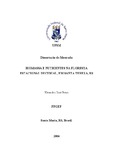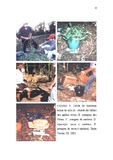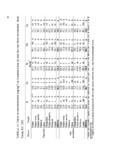| dc.description.abstract | It had been esteemed the accumulated biomass above and below the soil in two succession phases of a Seasonal Deciduous Forest (brushwood and secondary forest) located in Santa Tereza, RS, and the concentrations and contents of macronutrients, micronutrients and organic carbon in the biomass, allied to the study of the physical and chemistries characteristics of the soil in this areas and to the calculation of the forests nutrients efficiency use. Using three random 10 m x 10 m stands in each area, the individuals had been divided in stratum: herbaceous, bush, arboreal and lianas. All the fractions had been weighted and sub-sampling for sending to the laboratory (fractions had been dried, weighted and analyzed). For the bark percentage determination, it had been removed three disks from each tree (one at the base, other at the middle and the last one at the log s end). The accumulated biomass above the soil reached 102,3 Mg ha-1 in the brushwood (2.25% leaves; 20.68% alive branches; 0.80% branches died; 49.95% wood; 7.51% bark; 0.24% leaves of the bush stratum; 3.40% wood/branches of the bush stratum; 0.92% herbaceous stratum and 14.24% lianas) and, in the secondary forest, of 157,6 Mg ha-1 (2.23% leaves; 28.37% alive branches; 1.94% died branches; 52.41% wood; 6.76% bark; 0.19% leaves of the bush stratum; 2.65% wood/branches of the bush stratum; 0.48% herbaceous stratum and 4.97% lianas). The biomass of thick roots had superior accumulation in the secondary forest (38.83 Mg ha-1) in relation to the brushwood (24.95 Mg ha-1). The fine roots presented superior total biomass in the brushwood (7.93 Mg ha-1 against 2.84 Mg ha-1 in the secondary forest). The density of fine roots had been superior at the first soil layer, where, in the brushwood, 45.5% and 67.8% of fine roots are between 0-10 and 0-20 cm of soil, respectively, against 29.9% and 52.1% in the secondary forest. The accumulated litter on the soil reached 7.25 Mg ha-1 in the brushwood and 9.81 Mg ha-1 in the secondary forest. The fraction that present the largest macronutrients contents is the foliar. The biomass above the soil accumulates, in the brushwood (kg ha-1): 41808.1 (C); 1097.7 (N); 67.2 (P); 743.4 (K); 1681.4 (Ca); 132.6 (Mg); 77.6 (S); 1.96 (B); 0.70 (Cu); 6.47 (Fe); 3.01 (Mn) and 2.19 (Zn). In the secondary forest, the nutrients accumulation in biomass above the soil reaches (kg ha-1): 65473.6 (C); 1531.5 (N); 94.0 (P); 1005.7 (K); 2443.3 (Ca); 288.8 (Mg); 114.7 (S); 2.54 (B); 1.09 (Cu); 27.91 (Fe); 23.96 (Mn) and 4.34 (Zn). The roots present (kg ha-1): 13520.7 C; 434.0 N; 19.8 P; 161.2 K; 549.2 Ca; 59.2 Mg; 19.8 of S; 1.22 B; 0.33 Cu; 93.8 Fe; 4.68 Mn and 1.23 of Zn for the brushwood. In the secondary forest, the roots accumulate: 17156.9 C; 566.7 N; 29.2 P; 237.5 K; 579.3 Ca; 129.2 Mg; 58.4 S; 1.51 B; 0.45 Cu; 119.6 Fe; 10.32 Mn and 2.31 Zn. The litter had been presented, in the brushwood, a stock of (kg ha-1): 2825.6 (C); 95.0 (N); 3.6 (P); 18.1 (K); 156.0 (Ca); 13,8 (Mg); 6.5 (S); 0.28 (B); 0.08 (Cu); 9.83 (Fe); 2.83 (Mn) and 0.37 (Zn). In the secondary forest, the nutrients accumulation in the litter is (kg ha-1): 3762.4 (C); 115.8 (N); 4.9 (P); 26.5 (K); 220.7 (Ca); 15.7 (Mg); 6.9 (S); 0.31 (B); 0.11 (Cu); 9.94 (Fe); 1.82 (Mn) and 0.38 (Zn). The soil density reached smaller values in the superficial soil layer, increasing up to 30 cm and after that presenting values variables, for two sucession phases, with larger values in the brushwood. The two subseres soil had been presented characteristics of good or enough fertility, where just the contents of P, in two areas, and the K contents, in the brushwood, had been considered low. The amount of accumulated nutrients in the brushwood soil, up to 60 cm of depth, in kg ha-1, was: 112855.8 (C); 9728.2 (N); 24.6 (P); 298.8 (K); 35794.9 (Ca) and 5222.4 (Mg). In the secondary forest, the accumulation was: 112579.3 (C); 9704.3 (N); 25.3 (P); 553.3 (K); 30930.2 (Ca) and 4402.2 (Mg). The nutrients efficiency use tends to increase with the age of the vegetable succession, for most of the nutrients, implicating in a better nutrients use. The total biomass fraction with larger accumulation is the wood increasing your participation with elapsing of the forest age. | eng |
| dc.description.resumo | Foram estimados a biomassa acumulada acima e abaixo do solo em duas fases sucessionais de uma Floresta Estacional Decidual (capoeirão e floresta secundária) em Santa Tereza, RS, e as concentrações e quantidades de macro, micronutrientes e carbono orgânico na biomassa, aliadas ao estudo das características físicas e químicas do solo das áreas e ao cálculo da eficiência de utilização dos nutrientes pelas florestas. Com o uso de 03 parcelas aleatórias de 10 m x 10 m em cada área, foram divididos os indivíduos nos estratos: herbáceo, arbustivo, arbóreo e lianas. Todas as frações foram pesadas e subamostradas para análise laboratorial (secagem, pesagem e análise química). A percentagem de casca foi determinada com base na retirada de 3 discos (na base, no meio e no final) de cada tronco. A biomassa acumulada acima do solo foi de 102,3 Mg ha-1 no capoeirão (2,25% folhas; 20,68% galhos vivos; 0,80% galhos mortos; 49,95% madeira do fuste; 7,51% casca; 0,24% folhas do estrato arbustivo; 3,40% madeira/galhos do estrato arbustivo; 0,92% estrato herbáceo e 14,24% lianas) e, na floresta secundária, de 157,6 Mg ha-1 (2,23% folhas; 28,37% galhos vivos; 1,94% galhos mortos; 52,41% madeira do fuste; 6,76% casca; 0,19% folhas do estrato arbustivo; 2,65% madeira/galhos do estrato arbustivo; 0,48% estrato herbáceo e 4,97% lianas). A biomassa de raízes grossas teve acúmulo superior na floresta secundária (38,83 Mg ha-1) em relação ao capoeirão (24,95 Mg ha-1). As raízes finas apresentaram biomassa superior no capoeirão (7,93 Mg ha-1 contra 2,84 Mg ha-1 na floresta secundária). A densidade de raízes finas foi superior na primeira camada de solo, onde, no capoeirão, 45,5% e 67,8% das raízes finas estão entre 0-10 e 0-20 cm de solo, respectivamente, contra 29,9% e 52,1% na floresta secundária. A serapilheira acumulada sobre o solo atingiu 7,25 Mg ha-1 no capoeirão e 9,81 Mg ha-1 na floresta secundária. As frações que apresentam os maiores teores de nutrientes são as foliares. A biomassa acima do solo acumula, no capoeirão (kg ha-1): 41808,1 (C); 1097,7 (N); 67,2 (P); 743,4 (K); 1681,4 (Ca); 132,6 (Mg); 77,6 (S); 1,96 (B); 0,70 (Cu); 6,47 (Fe); 3,01 (Mn) e 2,19 (Zn). Na floresta secundária, o acúmulo de nutrientes na biomassa acima do solo alcança (kg ha-1): 65473,6 (C); 1531,5 (N); 94,0 (P); 1005,7 (K); 2443,3 (Ca); 288,8 (Mg); 114,7 (S); 2,54 (B); 1,09 (Cu); 27,91 (Fe); 23,96 (Mn) e 4,34 (Zn). As raízes apresentam (kg ha-1): 13520,7 C; 434,0 N; 19,8 P; 161,2 K; 549,2 Ca; 59,2 Mg; 19,8 de S; 1,22 B; 0,33 Cu; 93,8 Fe; 4,68 Mn e 1,23 de Zn para o capoeirão. Na floresta secundária, as raízes acumulam: 17156,9 C; 566,7 N; 29,2 P; 237,5 K; 579,3 Ca; 129,2 Mg; 58,4 S; 1,51 B; 0,45 Cu; 119,6 Fe; 10,32 Mn e 2,31 Zn. A serapilheira apresenta, no capoeirão, um estoque de (kg ha-1): 2825,6 (C); 95,0 (N); 3,6 (P); 18,1 (K); 156,0 (Ca); 13,8 (Mg); 6,5 (S); 0,28 (B); 0,08 (Cu); 9,83 (Fe); 2,83 (Mn) e 0,37 (Zn). Na floresta secundária, o acúmulo de nutrientes na serapilheira é de (kg ha-1): 3762,4 (C); 115,8 (N); 4,9 (P); 26,5 (K); 220,7 (Ca); 15,7 (Mg); 6,9 (S); 0,31 (B); 0,11 (Cu); 9,94 (Fe); 1,82 (Mn) e 0,38 (Zn). A densidade do solo atingiu valores menores na camada superficial de solo, aumentando até 30 cm, e, após isso, apresentou valores variáveis, para as duas fases sucessionais, com valores maiores no capoeirão. O solo das duas subseres apresentou características de boa ou suficiente fertilidade, em que apenas os teores de P, nas duas áreas, e os teores de K, no capoeirão, são considerados baixos. A quantidade de nutrientes acumulados no solo do capoeirão, até 60 cm de profundidade, em kg ha-1, foi de: 112855,8 (C); 9728,2 (N); 24,6 (P); 298,8 (K); 35794,9 (Ca) e 5222,4 (Mg). Na floresta secundária, o acúmulo foi de: 112579,3 (C); 9704,3 (N); 25,3 (P); 553,3 (K); 30930,2 (Ca) e 4402,2 (Mg). A eficiência de utilização dos nutrientes tende a aumentar com a idade da sucessão vegetal, para a maioria dos nutrientes, implicando em melhor aproveitamento dos mesmos. A fração da biomassa total com maior acúmulo é a madeira, aumentando sua participação com o transcorrer da idade da floresta. | por |




